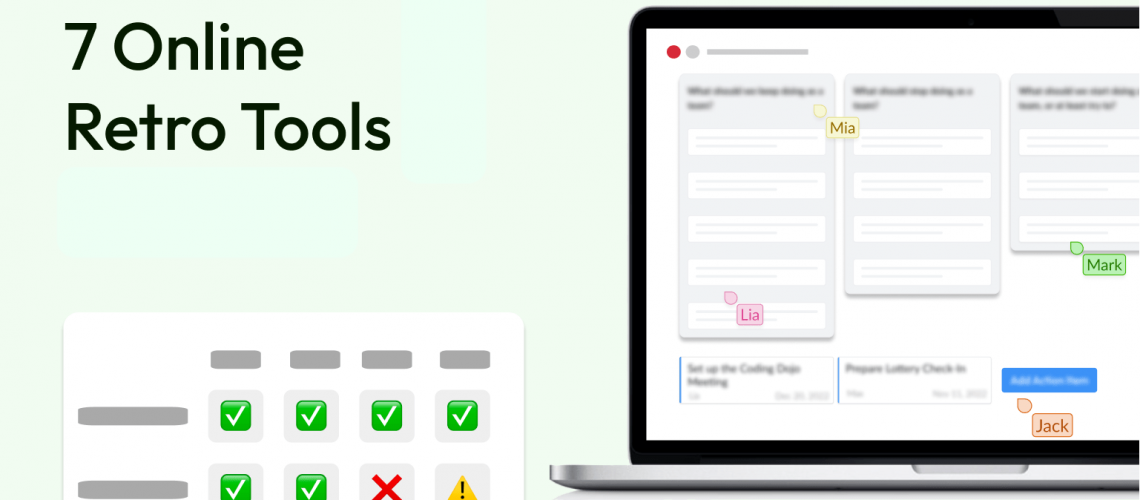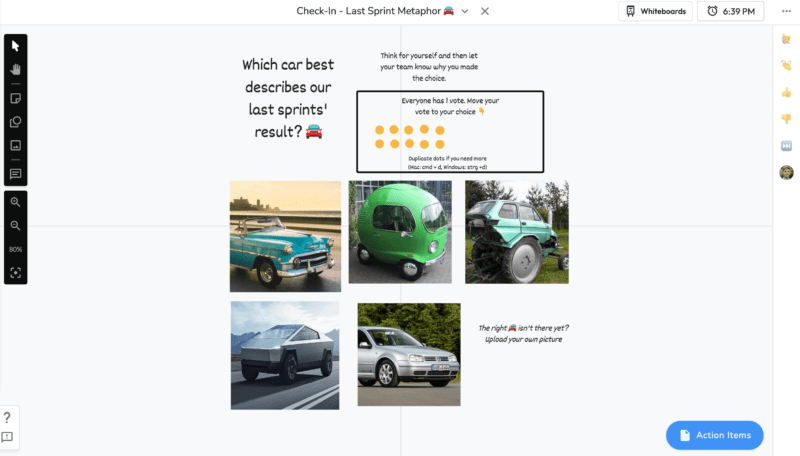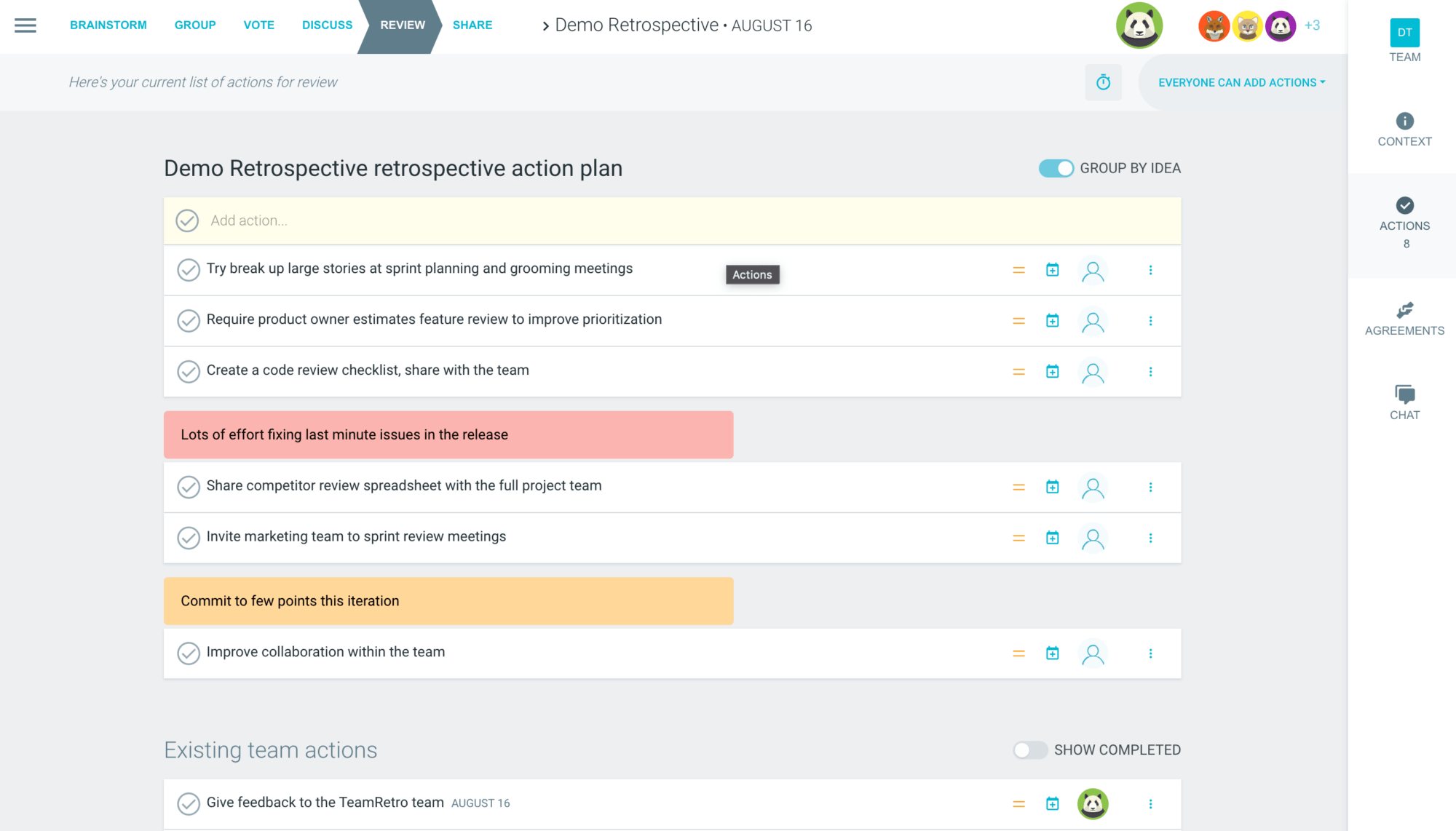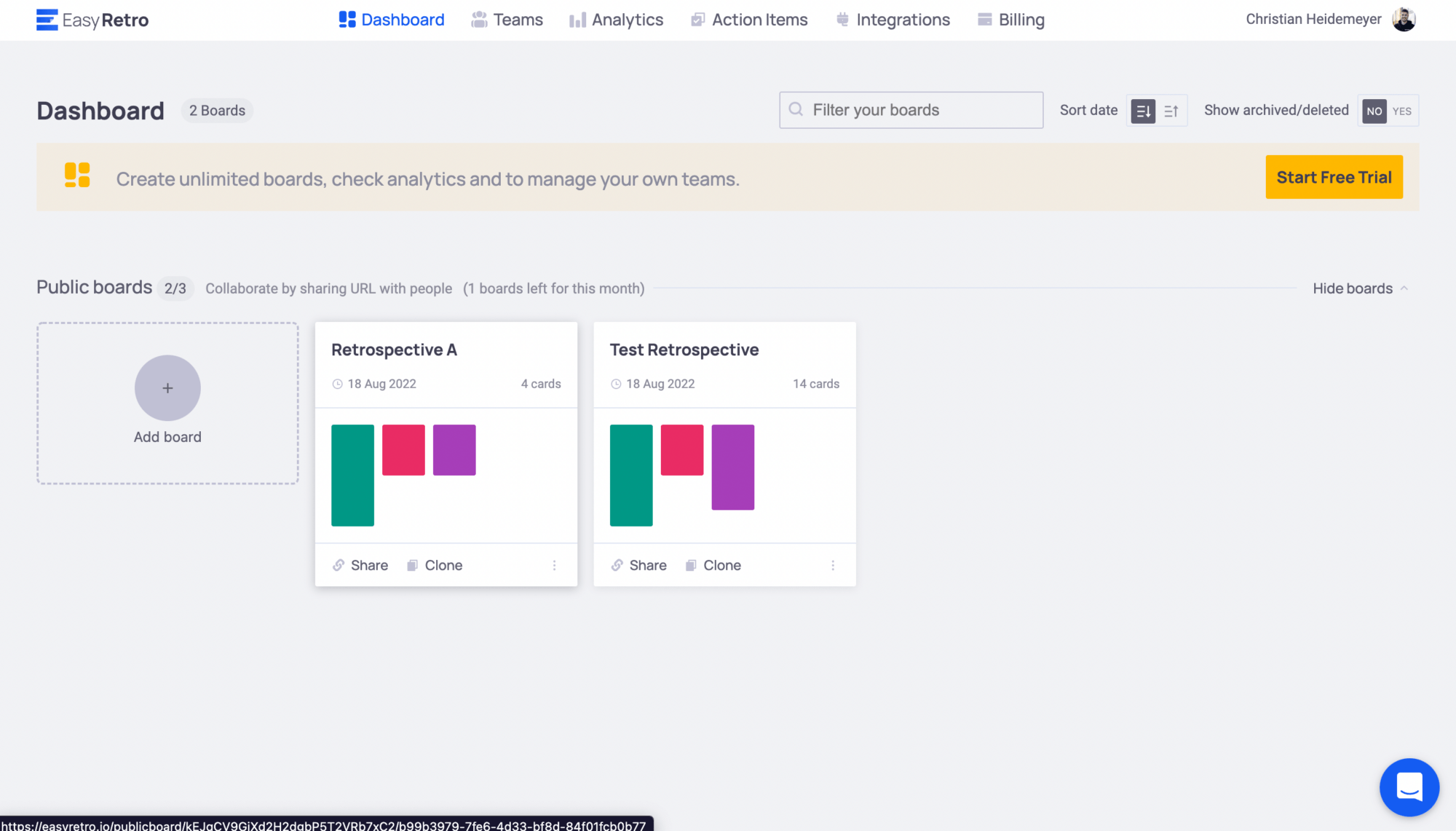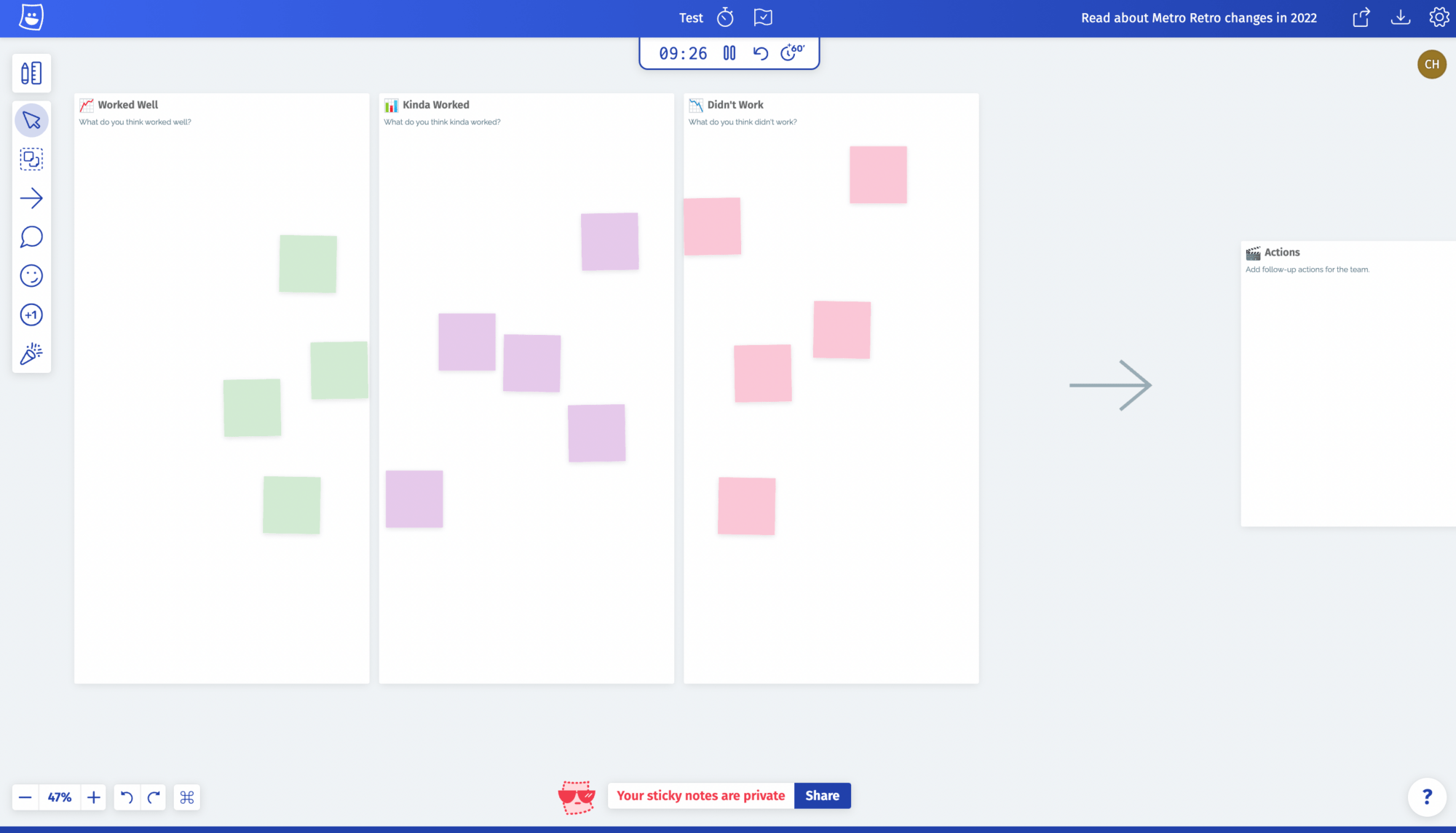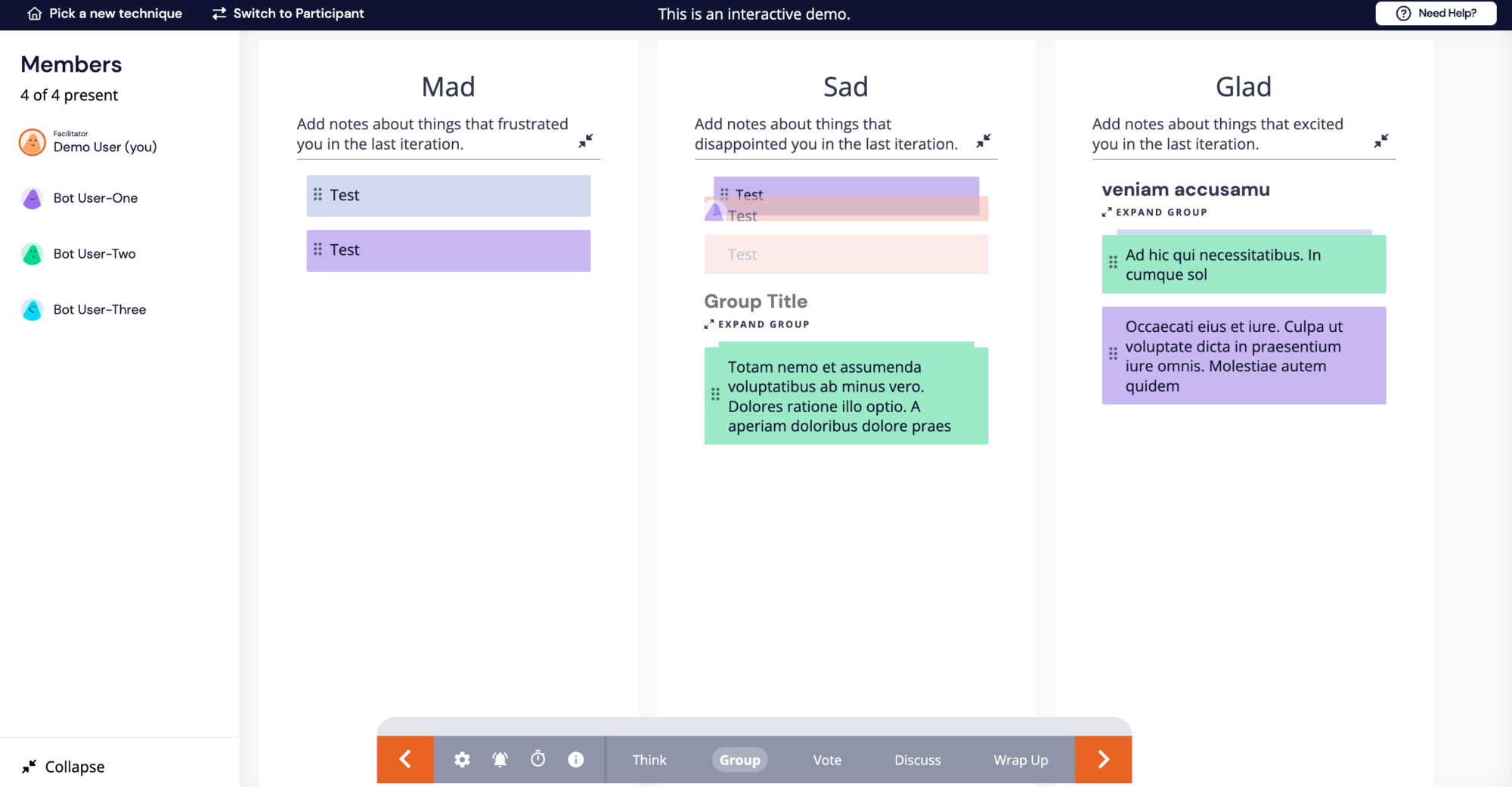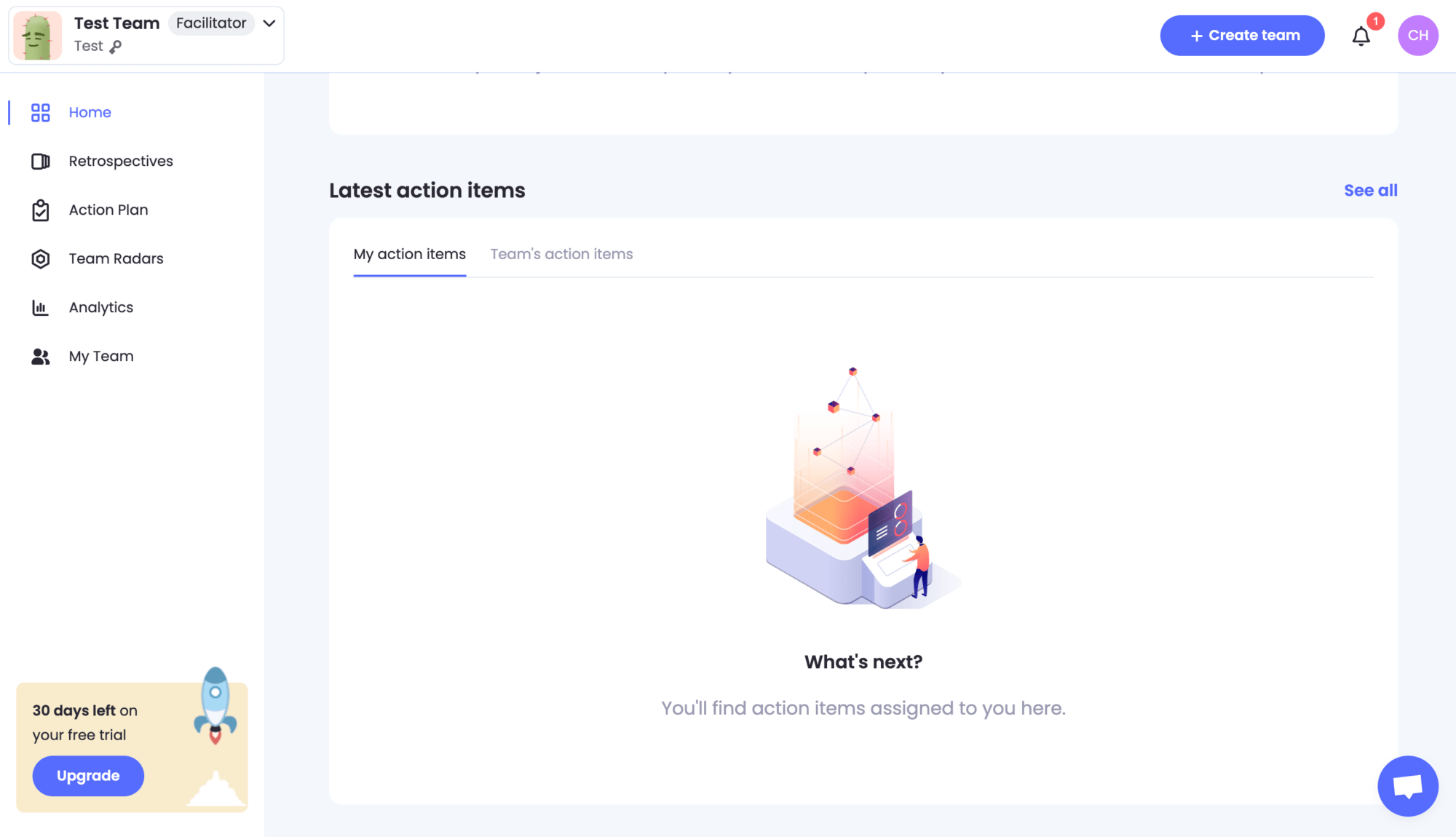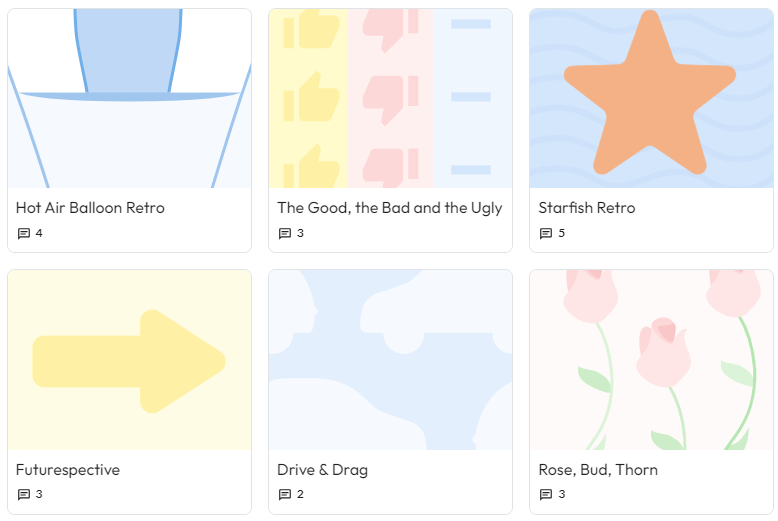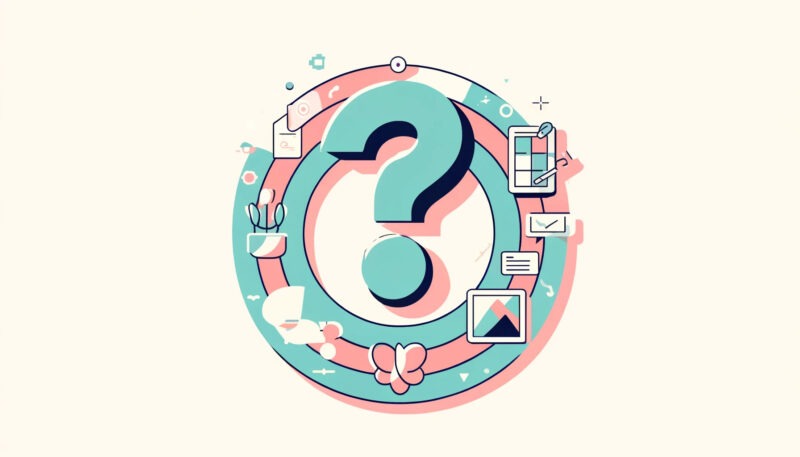Alright, for those of you who are impatient: You can jump start a free retrospective and start your teams retro online following this link:
For everyone else, I made an in depth comparison of the best team retrospective tools to facilitate retros online below. Why do I think they are the best free online retrospective tools? I tried to be objective here and simply looked at their website traffic. Find more on this below.
The 7 best retrospective tools online for your teams retro
We will compare the following best retrospective tools to do retros online:
- Echometer: Mindset Retros
- Teamretro: Easy retros
- Easyretro: Remo. collaboration
- Metro Retro: Engaging retros
- Parabol: Agile meetings
- Retrium: Enabling conversations
- Neatro: Effective retros
| Evaluation criteria | Echometer | Retrium Board | Team Retro | FunRetro former EasyRetro Board | Parabol Board | MetroRetro Board |
|---|---|---|---|---|---|---|
| Interactive online retrospectives |  Yes Yes |  Yes Yes |  Yes Yes |  Yes Yes |  Yes Yes |  Yes Yes |
| Automatically generated retro summaries |  Yes Yes |  Yes Yes |  Yes Yes |  Yes Yes |  Yes Yes |  Yes Yes |
| Supported facilitation (Check-In Generator etc.) |  Yes Yes |  Yes Yes |  Partially Partially |  No No |  Partially Partially |  Partially Partially |
| Templates for every level of team maturity |  Yes Yes |  Partially Partially |  Partially Partially |  No No |  No No |  No No |
| Continuous tracking of action items (retro to retro) |  Yes Yes |  Partially Partially |  Partially Partially |  No No |  Yes Yes |  No No |
| Team development measured over time |  Yes Yes |  Partially Partially |  Yes Yes |  No No |  No No |  No No |
| Collecting feedback before retros (optional) |  Yes Yes |  No No |  No No |  No No |  Yes Yes |  No No |
| Organizational Health Checks |  Yes Yes |  No No |  No No |  No No |  No No |  No No |
| Health Check Item Pool with nudges (food for thought) |  Yes Yes |  No No |  No No |  No No |  No No |  No No |
| Mobile Device Support for on-site retros |  Yes Yes |  No No |  No No |  No No |  No No |  No No |
| Integrated Online-Whiteboard |  Yes Yes |  No No |  No No |  No No |  No No |  Yes Yes |
| Data protection (developed and hosted in Europe) |  Yes Yes |  No No |  No No |  No No |  No No |  No No |
| Free version (after trial) |  Yes Yes |  No No |  No No |  Yes Yes |  Yes Yes |  Yes Yes |
7 tools for retrospectives - #1
Software Retrospective: Echometer
Customer Testimonials & Review Echometer
Quick intro on Echometer's website
“Most Agile Coaches and Scrum Masters run in circles fixing superficial symptoms. Time to use psychology to sustainably foster mindset change - through the Echometer retro tool."
Echometer Website: https://echometerapp.com/
Retros online: Echometer features
Overall, the Echometer tool has 9.5 out of 10 of the key features of a retrospective tool (see toggle).
| Features to foster outputs | Features to foster outcomes |
|---|---|
 Action item Support & Tracking Action item Support & Tracking |  ROTI metric ROTI metric |
 Flexible whiteboard or similar Flexible whiteboard or similar |  Team Health Checks Team Health Checks |
 Various retro templates Various retro templates |  Team Health Templates Team Health Templates |
 Support of facilitator Support of facilitator | |
 Effective Timer Effective Timer | |
 Optional anonymity Optional anonymity | |
 Intuitive UX & attractive design Intuitive UX & attractive design |
In the retro
Online Retrospective Tool (Free): One of the Whiteboard Check-In's
The Health Check visualization
…within the Retro:
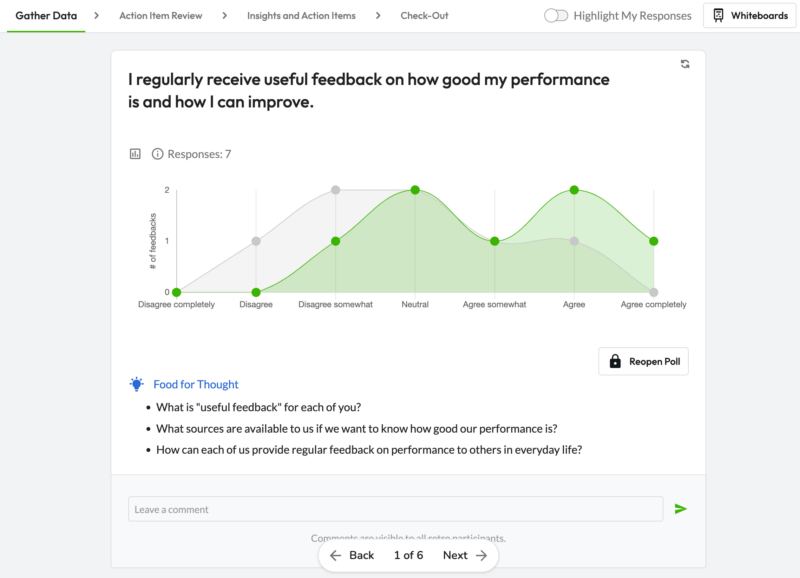
Preparing a retro
Various team templates for different levels of agile maturity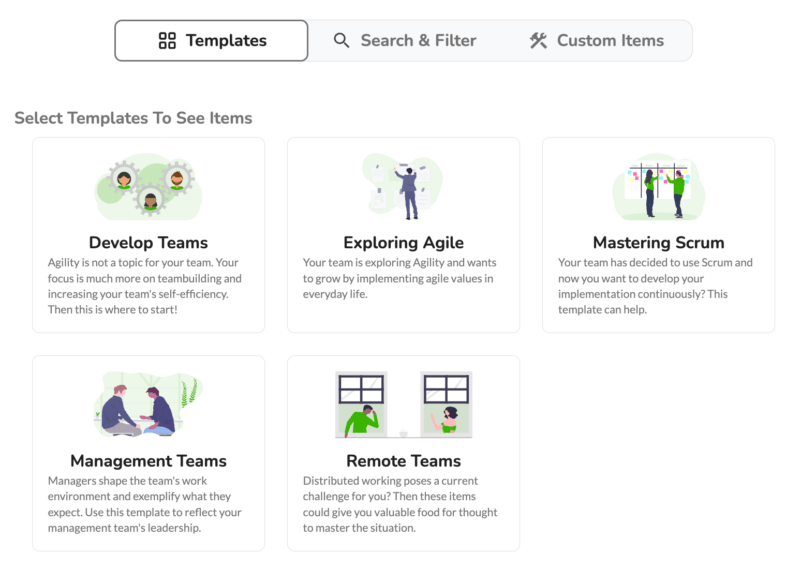
Online Retrospective Scrum Tool (Free): Examples of Health Check Items
...within the area of "agility":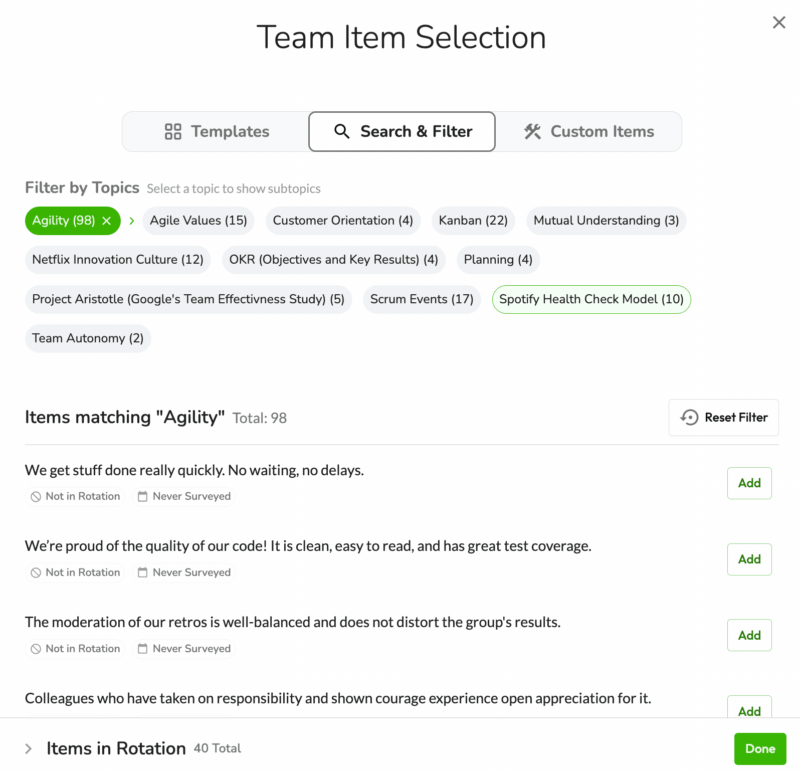
Cross-Team Analysis
Department-wide overview of number of action items etc.
Digital Retrospective Tool (Free): Cross-Team Health Check in Heatmap & Radar Chart view
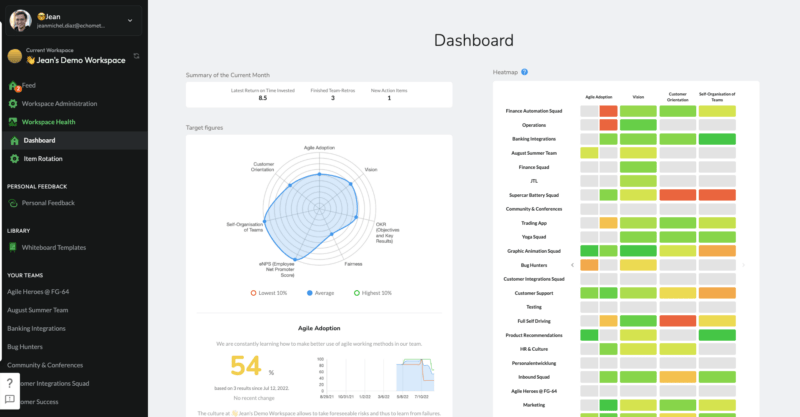
Two more quick hints regarding Echometer:
- If you are looking for a free retrospective tool without login are looking for, or an online retrospective tool without registration, then Echometer is the right choice. You can easily look around the entire retro without registering. If you are logged in to a retro yourself, you can invite colleagues without them having to log in. – is also a retrospective tool without a login.
- Echometer has an integration with Jira. So if you are looking for a retrospective tool in Jira or a retrospective tool for Jira, our tool is worth checking out for sure 🙂.
Pros & Cons: Echometer tool for retrospectives
 Pro Pro  |
 Con's Con's  |
|---|---|
 All core features existing All core features existing |
 User experience needs improvement – work in progress! User experience needs improvement – work in progress! |
 Easy handling & focus on data-driven coaching Easy handling & focus on data-driven coaching |
|
 Even cross-team health checks possible Even cross-team health checks possible |
|
 Workshop templates based on psychology (impact on retro outcomes) Workshop templates based on psychology (impact on retro outcomes) |
Echometer Pricing, Free Trial & Access
- Free trial: 21 days
- Free version (after the free trial): Yes
- Base price (after the free trial): From 29€ per team per month (see link below for possible changes in the pricing model).
In summary, Echometer is easy to use for individual Scrum Masters, Agile Coaches, Product Owners or other retrospective facilitators. And it even offers some "premium features" for Agile Coaches in an environment with a lot of "Agile at scale" (see screenshots above).
Just follow one of the buttons or retro methods below to open your first retro now and optionally invite your agile team via link to our Sprint Retro App:
Echometer is the right choice for you if you want to develop a single teams and organizations at all levels - which makes it the only solution you could call an online retrospective platform. It provides you and your agile coaching team with a continuous health check of the maturity of teams, makes successes of your agile transformation visible (as a team radar online tool) and is one of the few softwares with an optional retrospective whiteboard online (including retrospective voting tool, of course).
Tools used for Retrospective | No. 2
Software Retrospective: Teamretro
Customer testimonials & review team retro
Quick intro on Teamretro's website
"TeamRetro is an enterprise-ready online retrospective tool for remote teams. Our guided retrospective techniques ensure your retros are worthwhile – each and every time."
Teamretro Website: https://www.teamretro.com/
Retros online: Team retro features
Overall, the Teamretro tool has 7.5 of 10 of the key features of a retrospective tool (see Toggle; more on Team Retrospective Tool).
| Features to foster outputs | Features to foster outcomes |
|---|---|
 Action item Support & Tracking Action item Support & Tracking |  ROTI metric ROTI metric |
 Flexible whiteboard or similar Flexible whiteboard or similar |  Team Health Checks Team Health Checks |
 Various retro templates Various retro templates |  Team Health Templates Team Health Templates |
 Support of facilitator Support of facilitator | |
 Effective Timer Effective Timer | |
 Optional anonymity Optional anonymity | |
 Intuitive UX & attractive design Intuitive UX & attractive design |
The Retro Summary – Tools for Online Retrospective

The Retro Tool App Board – Tools for online retrospective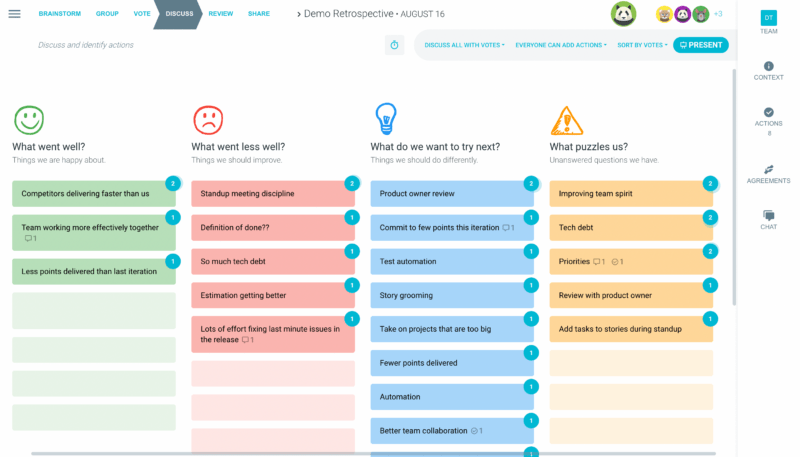
The preparation of the Retro Tool Format – Software Team Retrospective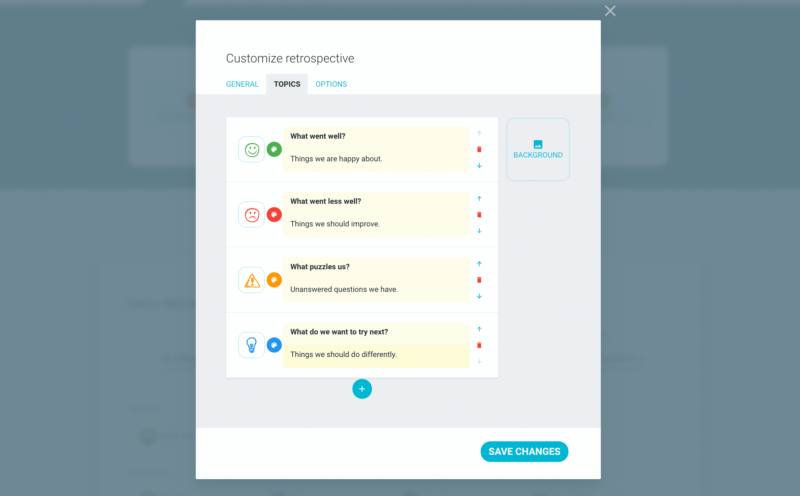
Pro & Cons: Team retro tool for retrospectives
| ☀️ Pro ☀️ | 🌧 Cons 🌧 |
|---|---|
| 👍 Long list of features | 💔 One of many GroupMap products - accordingly, no development focus |
| 👍 Relevant integrations | 💔 No clear unique selling proposition |
| 👍 Business API |  No “free forever” option No “free forever” option |
Teamretro Pricing, Free Trial & Access
- Free trial: 30 days
- Free version (after the free trial): No
- Basic price (after the free trial): Beginning at €25/team/month
Conclusion, Tips & Further Thoughts (Retrospective Remote Tools)
Looking at this analysis as a whole, this tool deserves to be called one of the best retro tools for remote teams. You can read about who else made the list here: The best retro tools for remote teams. It is not only an anonymous retrospective tool, but also has ROTI functionality (More information on: Free anonymous retrospective tool).
I believe that the quality of retros is in itself an indication of the maturity of teams. With that in mind, the ROTI (return on time invested) score is basically that too: An agile KPI. And one to consider when it comes to this: Measure the agile maturity level.
If you want to learn more on why I believe this, feel free to have a look into my post "7 tips for teams with retro fatigue". “Retro fatigue” meaning: the team considers that the sprint retrospective isn’t necessary. What can you as a Scrum Master do about this? This is what the text is about - and what you might learn for your teams retro.
Sorry for the digression. Actually, I just wanted to say: I think it is very good that the Teamretro Retro Meeting Tool also offers this function of measuring the ROTI score (More on: Retrospective Meeting Tool). And it is also a team radar online tool – #ILike. Now we move on to the next free agile retrospective tool that helps to conduct retrospectives online.
Tools for Retrospective | No. 3
Customer Voices & Review Easyretro io (formerly FunRetro) Easyretro io (formerly FunRetro)
Quick intro on Easyretro io (formerly FunRetro's) website
"Improve with Fun Sprint Retrospectives: Collaborate with your remote team and get better at what you do with a simple, intuitive and beautiful tool."
Easyretro.io (formerly FunRetro) Website: https://easyretro.io/
Retros online: features of Easyretro io (formerly FunRetro)
Overall, the Easyretro.io or FunRetro tool has 4.5 of 10 of the central features of a retrospective tool (see Toggle; more on Team Retrospective Tool).
| Features to foster outputs | Features to foster outcomes |
|---|---|
| ⚠️ Action item Support & Tracking | ❌ ROTI metric |
| ⚠️ Flexible whiteboard or similar | ❌ Team Health Checks |
| ☑️ Various retro methods | ❌ Team Health Templates |
| ❌ Support of facilitator | |
| ☑️ Effective timer | |
| ☑️ Optional anonymity | |
| ⚠️ Intuitive UX et attractive design |
EasyRetro (formerly FunRetro) Retro Board – Sprint Retrospective Online Tools (Free)
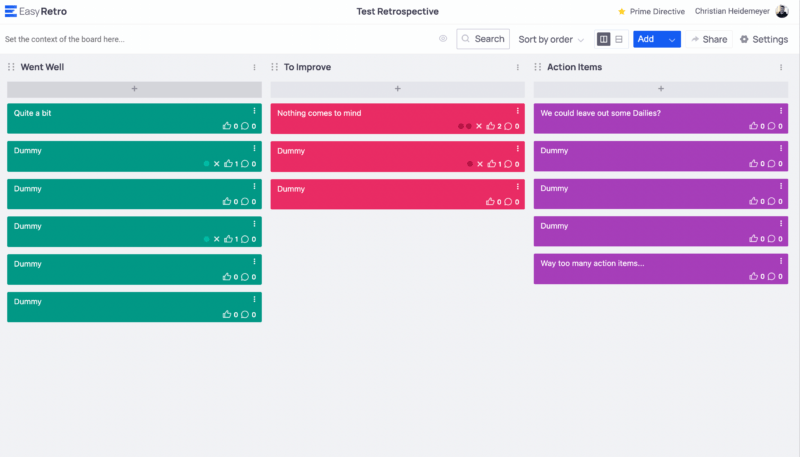
Easyretro or FunRetro Tool Formats – Free Software for Retrospective
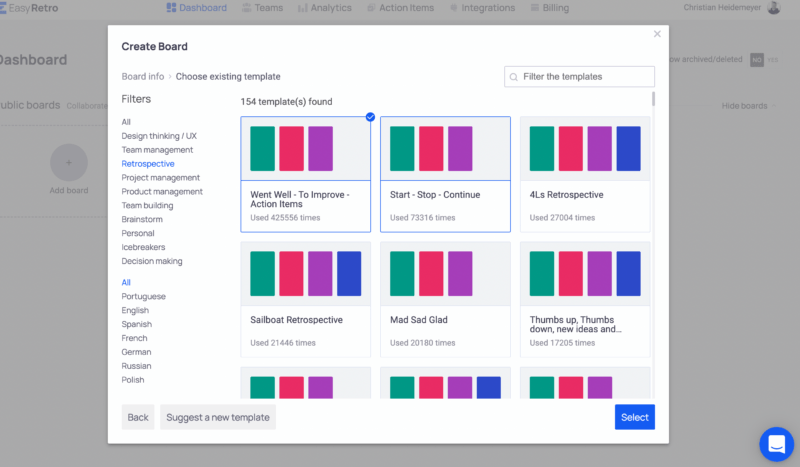
Settings in the retro preparation – Free Software for Retrospective

Pro Contra: Easyretro.io (formerly FunRetro) Retrospective tool
 Pro Pro  |  Con's Con's  |
|---|---|
 Long list of retro methods Long list of retro methods |  None of the features to foster retro outcomes (see above) None of the features to foster retro outcomes (see above) |
 Relevant integrations Relevant integrations |  Design not very appealing Design not very appealing |
 Although it's called "EasyRetro", unfortunately, UX was not that intuitive for us Although it's called "EasyRetro", unfortunately, UX was not that intuitive for us |
Easyretro io (formerly FunRetro) Pricing, Free Trial & Access
- Free trial: 7 days
- Free version (after free trial): Yes, incl. 3 public retro boards
- Basic price (after free trial): Beginning at €26/team/month
Conclusion, tips & further thoughts (Virtual Retrospective Tools) (Virtual Retrospective Tool)
Given these features, Easyretro is still one of the best free retrospective tools for distributed Scrum teams. "Funretro improve your team with fun sprint retrospectives" summarizes it pretty well.
If you want to learn more about Easyretro or Funretro pricing, the anonymity feature or their retro board etc, just check out their website. In any case, it's one of the few free tools for anonymous retrospectives. Here we have made a compilation about it: Free tools for anonymous retrospectives.
Regardless of how you conduct the agile retrospective online and which retrospective tool you choose, you should consider the following: The 5 phases of a retrospective. Each of the 5 phases, including check-in and check-out, has its raison d'être and should be part of an online retro.
Did you know it exist: The sixth phase of a retrospective? It is a phase that is often missing. Basically, it's about taking time for something essential in any retro: The development of really good action items.
Anyway, let’s move on to the next in our list of best free retro tools (Scrum) to do retros online.
Retrospective Tools Free Online | No. 4
Retrospective Software Free: Metro Retro
Customer testimonial & Review MetroRetro
Quick intro on Metro Retro's website
"Metro Retro is a digital whiteboard optimized for software and product teams."
Metro Retro Website: https://metroretro.io/
Retros online: Metro Retro features
Overall, the Metro Retro Tool has 5.5 out of 10 of the key features of a retrospective tool (see toggle).
| Features to foster outputs | Features to foster outcomes |
|---|---|
| ❌ Action item Support & Tracking | ❌ ROTI metric |
 Flexible whiteboard or similar Flexible whiteboard or similar | ❌ Team Health Checks |
 Various retro templates Various retro templates | ❌ Team Health Templates |
 Support of facilitator Support of facilitator | |
 Effective Timer Effective Timer | |
 Optional anonymity Optional anonymity | |
 Intuitive UX & attractive design Intuitive UX & attractive design |
The Retro Summary
...see Retro Board.
Metro Retro formats - Setup view
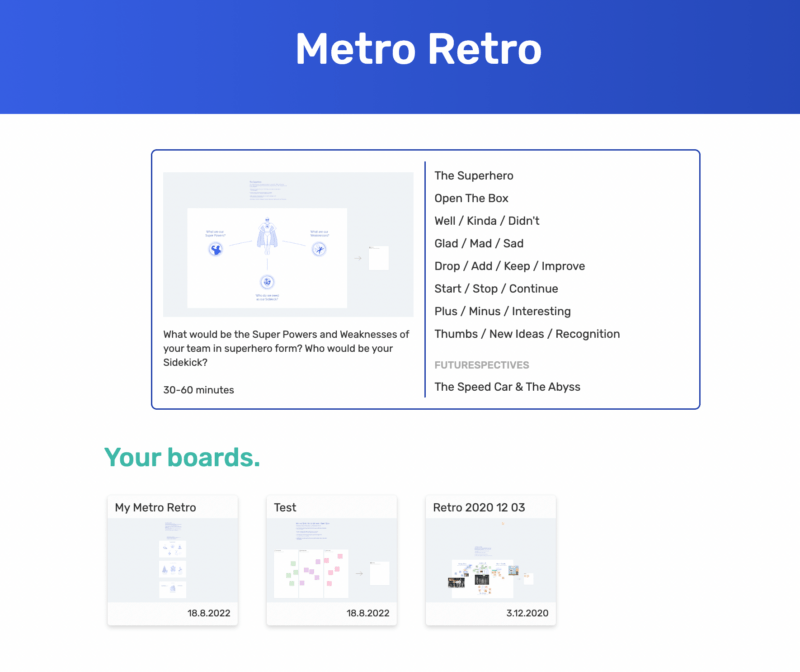
Pros & Cons: MetroRetro Tool for retrospectives
 Pro Pro  |  Con's Con's  |
|---|---|
 Some pretty retro methods Some pretty retro methods |  None of the features to foster retro outcomes (see above) None of the features to foster retro outcomes (see above) |
 Flexible whiteboard Flexible whiteboard |  Further development of the tool was announced a long time ago, not yet implemented (only 1-2 software developers behind it) Further development of the tool was announced a long time ago, not yet implemented (only 1-2 software developers behind it) |
MetroRetro Pricing, Free Trial & Access
- Free trial: 30 days
- Free version (after free trial): Yes (max. 3000 board items)
- Basic price (after the free trial): Beginning at 6$/team member/month
Conclusion, Tips & Further Thoughts (Retrospective Remote Tools)
Given these features, Easyretro is still one of the best free retro tools for distributed teams.
If you want to learn more about metro retro io, about the Metro Retro pricing, metro retro templates, see a metro retro tutorial to learn more about the metro retro tool in general, just have a look at their website metro retro.com.
As I mentioned above, you might argue that there are 6 phases of a retrospective. And the sixth phase is focusing on the development of action items.
I believe that good action items play a key role when it comes to improving the maturity level of teams (in any retro online). They are the output that is the precondition of one of the core outcomes of retrospectives: Continuous improvement.
And they are also closely related to learning the agile mindset. Why am I telling you all this? Because I believe that retro whiteboards (digital or paper) are a great place for flexible brainstorming of actions. So this is a clear advantage of Metro Retro (and Echometer) over the other remote retrospective tools: there is an online whiteboard for your retrospective (More on: Tools for Remote Retrospective).
To be more specific, for example, using the "5 Why" or the "Impact Effort Matrix" to develop measures is a good way to improve their quality and effectiveness. Click here to go directly there: 5 more example retro whiteboard templates to brainstorm good action items right here.
But now let’s get back to our remote agile retrospective tools (free, of course), to the next sprint retrospective apps that help you to facilitate retrospectives online. It doesn’t have retro whiteboard functionality, but it does have some other fancy add-ons.
Retrospective Tool Open Source | No. 5
Retrospective Software: Parabol
Customer testimonial & Review Parabol
Quick intro on Parabol's website
“Better Meetings, Less Effort. All your agile meetings in one place."
Parabol website: https://www.parabol.co/
Retros online: Parabol features
Overall, the Parabol Tool has 6.5 of 10 of the key features of a retrospective tool (see Toggle; more on Team Retrospective Tool).
| Features to foster outputs | Features to foster outcomes |
|---|---|
| ☑️ Action item Support & Tracking | ❌ ROTI metric |
| ⚠️ Flexible whiteboard or similar | ❌ Team Health Checks |
| ☑️ Various retro methods | ❌ Team Health Templates |
| ☑️ Support of facilitator | |
| ☑️ Effective timer | |
| ☑️ Optional anonymity | |
| ☑️ Intuitive UX & attractive design |
The retro summary of the retrospective tool for distributed team

The retro tool board of the retro tool for free

Check-in inside the retro of the retro tool for free
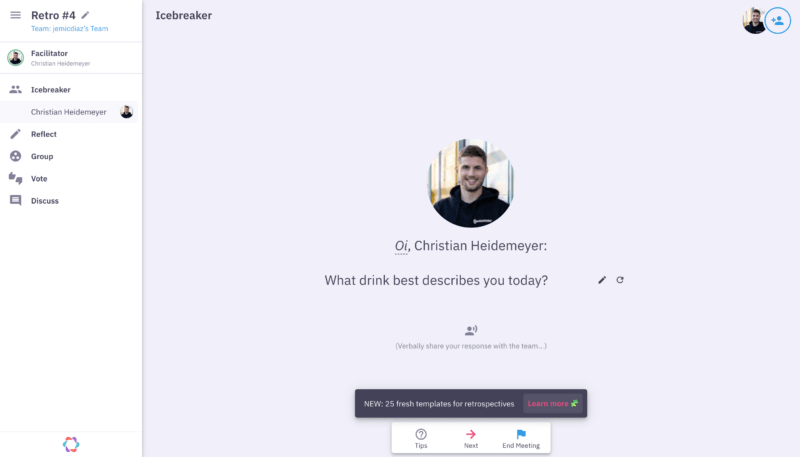
Pros & Cons: Parabol tool for retrospectives
 Pro Pro  |  Con's Con's  |
|---|---|
 Open source tool Open source tool |  None of the features to foster retro outcomes (see above) None of the features to foster retro outcomes (see above) |
 Other meeting formats available Other meeting formats available |  Pricing rather high Pricing rather high |
Parabol Pricing, Free trial & Access
- Free Trial: No
- Free version: Yes, up to 2 teams
- Base price: From 6$/team member/month
Conclusion, Tips & Further Thoughts (Retrospective Remote Tools)
Looking at this analysis, we can say that it is a good one in the category: Retrospective Meeting Tool. And it is, to my knowledge, the only remote retro tool that is open source.
If you want to learn more about the parabol retrospective tool, the Parabol company, the parabol pricing, see more parabol reviews etc. just have a look at their website.
I agree with Woody Zuill who said: “If you adopt only one agile practice let it be retrospectives. Everything else will follow.”
Retrospectives are the core ceremony in Scrum. But of course, there are other types of meetings that play a role. So I really like Parabol’s approach, trying to connect other agile meetings into their platform.
Let’s come to the next neat free retrospective (remote) tool: Retrium.
Online Solutions Tool Retrospective | No. 6
Retrospective Software: Retrium
Customer testimonial & Review Retrium
Quick intro on Retrium's website
“Retrium enables agile teams to have effective conversations, discover new insights, and generate action plans.”
Retrium website: https://www.retrium.com/
Retros online: Retrium features
Overall, the Retrium tool has 8.5 out of 10 of the core features of a retrospective tool (see toggle).
| Features to foster outputs | Features to foster outcomes |
|---|---|
| ☑️ Action item Support & Tracking | ⚠️ ROTI metric |
| ⚠️ Flexible whiteboard or similar | ⚠️ Team Health Checks |
| ☑️ Various retro methods | ☑️ Team Health Templates |
| ☑️ Support of facilitator | |
| ☑️ Effective timer | |
| ☑️ Optional anonymity | |
| ☑️ Intuitive UX & attractive design |
Measures management in Retrium – Scrum Retrospective Board Online Free
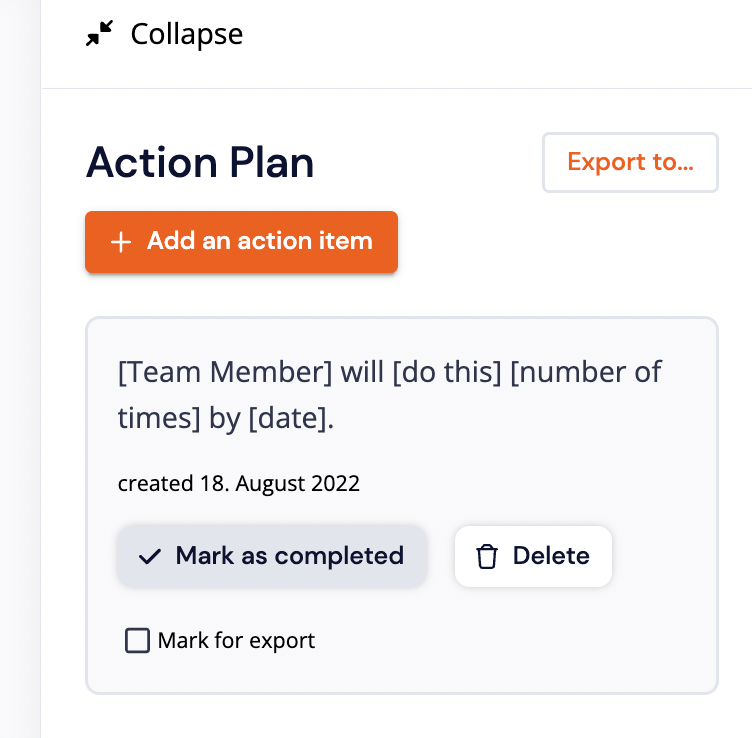
Measurement of the ROTI score in Retrium – Scrum Retrospective Board Online Free

Preparation of the retro format – Scrum Retrospective Online Tool (Free)
Pro & Cons: Retrium Tool for retrospectives
 Pro Pro  |  Con's Con's  |
|---|---|
 Long list of features Long list of features |  Pricing rather high Pricing rather high |
 Basic team health check is integrated Basic team health check is integrated |  No “free forever” option No “free forever” option |
Retrium Pricing, Free Trial & Access
- Free trial: 30 days
- Free version (after the free trial): No
- Basic price (after the free trial): Beginning at 39$/team/month
Conclusion, Tips & Further Thoughts (Virtual Retrospective Board)
Looking at this analysis, this tool deserves to be called one of the best retrospective tools for remote teams.
I think one of Retrium’s strengths is its clear UX. In my view it is simple to use. But one might ask: Is an iIntuitive UX even important? Or the question rather is, when is an intuitive UX important? When is an intuitive UX important?
I believe that the user interface should play an important role in choosing the right free online retro tool, especially if it is used by a rather immature team. Immature teams (i.e. teams with low agile maturity) are often skeptical when it comes to agile frameworks, whether Scrum or Kanban (More on: Retrospective Kanban Board). They do not have much patience and motivation to understand the particular tool.
So, for this type of teams, you should choose a retro online tool that is fun and offers a very intuitive user experience. For example, the classic should not be missing: Sailboat Retrospective Board. Of course, other retrospective formats should also be included.
Let’s move to the last free retro meeting tool.
Retrospective Online Free Tool | No. 7
Retrospective Software: Neatro
Customer testimonial & Review Neatro
Quick intro on Neatro's website
“Neatro is an online retrospective tool made for remote teams willing to improve continuously and stay Agile.”
Neatro website: https://www.neatro.io/
Retros online: Neatro features
Overall, the Neatro tool has 8 out of 10 of the key features of a retrospective tool (see toggle).
| Features to foster outputs | Features to foster outcomes |
|---|---|
| ☑️ Action item Support & Tracking | ⚠️ ROTI metric |
| ⚠️ Flexible whiteboard or similar | ⚠️ Team Health Checks |
| ☑️ Various retro methods | ☑️ Team Health Templates |
| ☑️ Support of facilitator | |
| ☑️ Effective timer | |
| ☑️ Optional anonymity | |
| ⚠️ Intuitive UX et attractive design |
The retro summary – Retrospective Board Columns
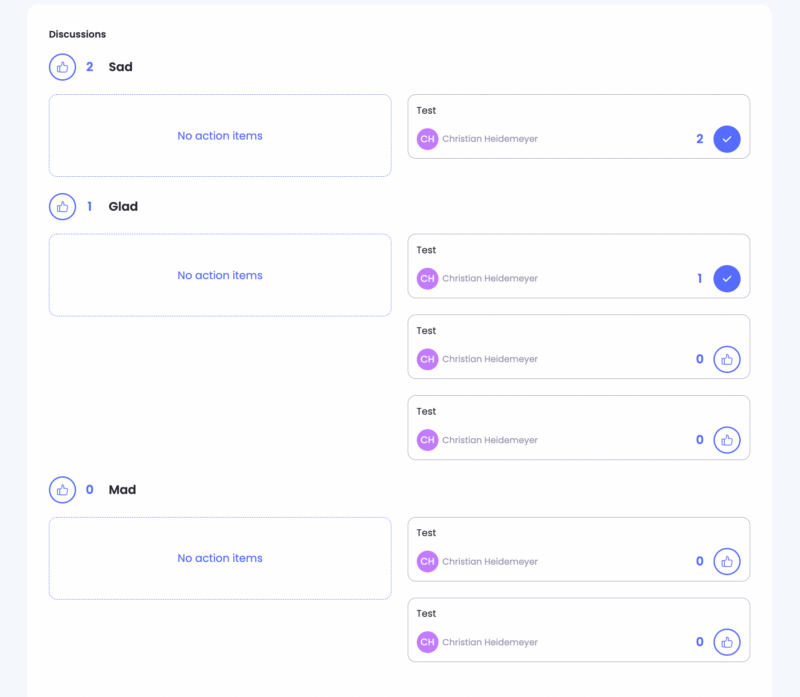
The Retro Check-In Screen – Retrospective Board Columns
Preparing the Retro tool format – Remote Retrospective Tools (Free)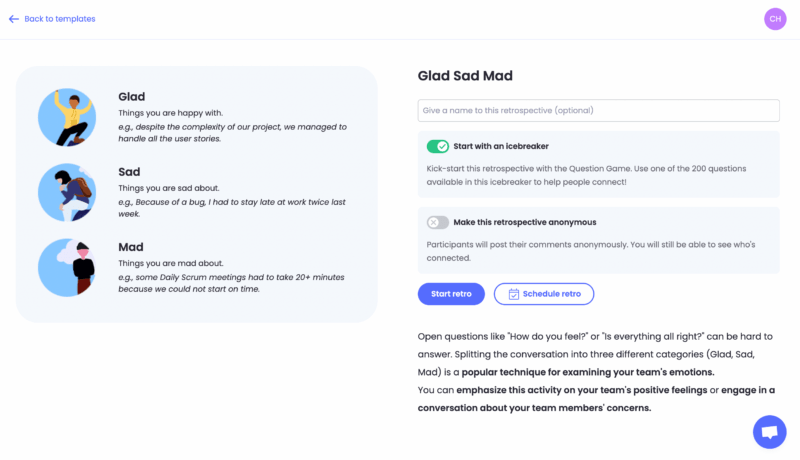
Pro & Cons: Neatro tool for retrospectives
 Pro Pro  |  Con's Con's  |
|---|---|
 Long list of various retro formats Long list of various retro formats |  No “free forever” option No “free forever” option |
 Basic team health check is integrated Basic team health check is integrated |
Neatro Pricing, Free Trial & Access
- Free trial: 30 days
- Free version (after the free trial): No
- Basic price (after the free trial): Beginning at 20$/team/month
Conclusion, tips & further thoughts (Virtual Retrospective Tools)
Neatro - another team radar online tool, nice! Looking at this analysis, this tool deserves to be called one of the best retrospective tools for remote teams.
And something else to keep in mind, because it correlates with team success: (Perceived) psychological safety in agile teams. And sharing feedback anonymously is an easy way for less mature agile teams to learn psychological safety over time in a Scrum retrospective.
Given this, I am very happy that Neatro and most of the other popular online retro tools (Scrum) offer the possibility of anonymous feedback. They are all an anonymous retrospective tool. This is by the way a disadvantage of many whiteboard tools like Miro and Mural that do not offer this feature, compared to the sprint retro apps we are discussing here.
Well, we're through. For those of you who want to better understand why we compared exactly these 10 core features of free Retro Tools online – find my rationale below.
Most Agile Coaches and Scrum Masters run in circles...
...fixing superficial symptoms. Time to use psychology to foster sustainable mindset change.
Evaluating 7 retrospective tools online - what we looked at (Summary)
Which online retro tool is right for your agile team? In summary, we looked at 8 different things in each retro tool:
I organized the comparison of free retro online tools in 8 categories:
- Screenshot of the agile retro tool
- Capterra Rating, as one of the key platforms that gives reviews of online cloud tools
- Short intro of the free online retrospective web tool, based on its website introduction (More about: Retrospective Web Tool)
- Feature Comparison of the agile retro tool
- Pro’s and Con’s of the agile retro tool
- A few example screenshots of what the free sprint retrospective online tools looks like
- One example testimonial of the agile retro tool
- Information on their pricing, including links to free trial and access to the retro tool
For those of you who are just looking for purely free retro tools: TeamRetro, Retrium and Neatro are each a Sprint retro app that do not offer a free version of their retro online tool, only a free trial version. So you could ignore these three tools in your comparison. Here we go!
How to choose the right tool in a smart way?
How can you find the right retro tool for your business? Good question! It is related to the question: What is a good retrospective actually about? Only when I know what a good retrospective is about can I compare tools in a meaningful way.
Therefore, I also wrote quite a bit about the outputs of retrospective tools and the outcomes of retrospectives in general. This gives us a great decision framework for evaluating the different online Scrum retrospective tools for agile that you might use in your teams retro. At the end of my analysis, you will know which best online retrospective tool is right for your online retrospective. Which will definitely help you running a retrospective remotely.
This post should also help you with the following question: how to do a retrospective online. It is actually quite simple, if the retro tool has a good UX. Therefore, the simplest way to understand how to conduct a retrospective meeting online is to try it out - you can find the direct access at the top of this post.
Of course, these few words are just a basic indication of what these Scrum retrospective tools for agile focus on and how they help you in running a retrospective remotely. We will go into more detail later. But before we do so, we should know what to focus on: What makes a good retro tool?
As mentioned above, to answer this question on the best retro tools (free), we should ask ourselves: What are the outputs and outcomes of retrospectives that we want to reach through this way? No matter if we use free retrospective tools for distributed Scrum teams or on-site ones…
Given this, let’s first align on what outcomes and outputs actually are.
Definition: Outcomes
Outcomes are your overall goals, for example what the company ultimately wants to achieve (on a rather abstract level).
Example Outcomes: The outcome of a change initiative in your organization could be higher employee satisfaction.
Definition: Outputs
Outputs are the actions or specific elements that contribute to the achievement of that outcome. You could say they are the prerequisites or operational things that are necessary to achieve the goal or outcome (e.g., what features does a Retrospective Web Tool provide; More on: Retrospective Web Tool).
Example Outputs: The outputs of a change initiative are regular employee workshops.
Software Retrospective: Our “Core Features”
If we ask the "why" question for retrospectives, we can answer what makes a good retrospective web tool (More on: Retrospective Web Tool). "Why" is there a need for retros? We should consider the important distinction between outputs and outcomes to answer this question.
What should be the outputs of retrospective tools, and what should be the outcomes of retrospectives in general? Which product features does this relate to? To give you a quick answer, have a look at the 2 graphics:
I am further elaborating on this below after the retrospective tool comparison' that compares solutions to facilitate retrospectives online. So if you want to learn more about which outcomes and outputs your teams retro should have, simply scroll down. These are the Outcomes of retros in general and the product features related to them by the way:
Which of the best free online retrospective tools is actually the best one with helping you get the given outputs and outcomes of agile retrospectives, doing retrospectives online?
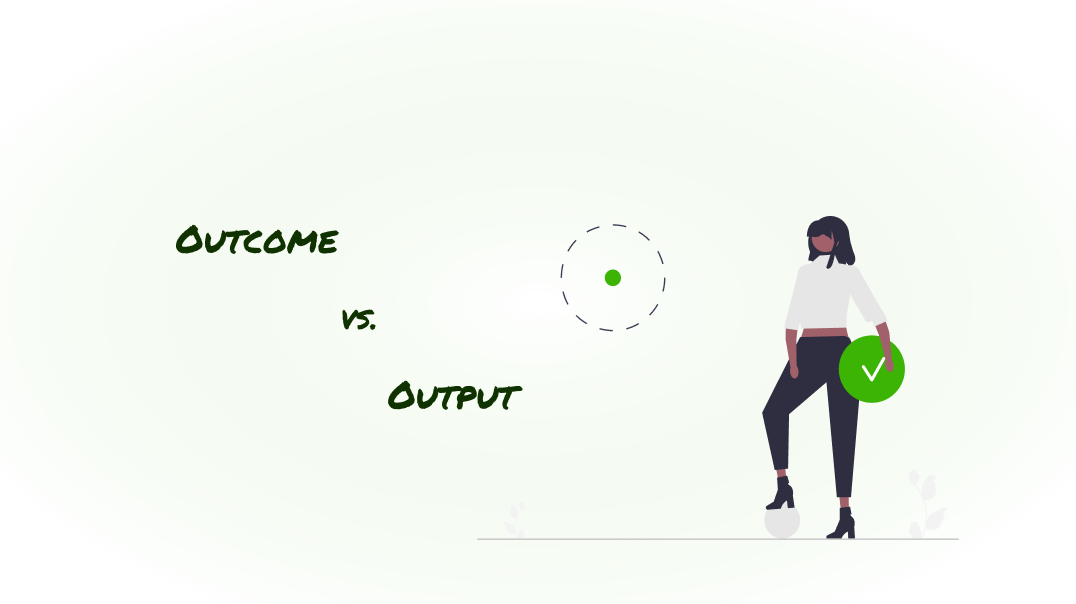
Outputs of a retrospective tool
Here we go - overall I see 7 different outputs of retrospectives, online and offline.
- Action items: The online retrospective app tool should take into account the 6th phase of a retrospective (see above, explanations for Easyretro aka Funretro).
- Feature: Action Item Support & Tracking.
- Fun, engagement and flexibility: This agile ceremony, compared to other ceremonies, can be engaging and fun. It should also be very flexible - the agenda might change due to urgent topics to discuss.
- Feature: Fun, interactive and flexible design (i.e., flexibility of a digital retro whiteboard).
- The right questions: The retrospective meeting tool should help ask the right questions and be flexible, i.e., adaptable to the team's needs (More on: Retrospective Meeting Board).
- Feature: Varied templates with good questions to reflect on past sprints and improve the team.
- Efficiency: The agile retro tool to do retrospectives online should help to save time in preparation and follow-up of the retrospective.
- Features: Pre-defined templates, optional asynchronous survey, support in facilitation, the right integrations with other tools, automated action item follow up.
- Good time boxing: To keep the focus of the team and the ROTI “Return on time invest” in balance.
- Feature: Effective timer.
- Safe atmosphere: To be able to speak up and share ideas without the fear of being judged by colleagues
- Feature: Optional anonymity when sharing feedback.
- Professionalism: Being perceived as a professional facilitator to earn the trust that is needed to develop a team over a long time.
- Feature: Professionally designed & working retrospective software with intuitive UX. Mobile support for hybrid teams (More on: Free agile retrospective software).
You can find an image above that shows a quick summary of the features I am mentioning here that any good free retrospective tool online should have.
All of these outputs have an influence on the outcomes of the retrospective (for any retro online and offline).
Outcomes of a teams retro
I see 4 different outcomes of doing retrospectives online (or offline and in general).
- Continuous improvement: One of the core ideas of agile is to continuously improve - and the retrospective is the core ceremony to support this.
- Feature: Measuring the ROTI score, “Return on time invest” as indication for the perceived quality of a retrospective (correlating with whether one actually improves).
- Agile Mindset: Regularly experiencing the positive effect of retrospectives, i.e., improvements of teamwork, leads to a phenomenon called self-efficacy. This phenomenon can have a massive effect on the “believe in agile” methods, thus in the Agile growth mindset overall - more on this in the linked post.
- Feature: Team health checks (or I should rather say Team fitness checks) including analytics over time can be of great help to regularly show how the team improved regarding agile maturity over time.
- Team spirit: One outcome of retrospective’s should be increased happiness, motivation and satisfaction of team members (i.e., something you could call team spirit and morale, although these are not really psychological terms).
- Features: a good team fitness check (incl. psychological validity & reliability) not only measures how you develop, but also to reflect on the psychological preconditions of team spirit & morale (e.g., the agile values).
- Psychological safety: Psychological safety is a precondition for sharing one's ideas and thoughts openly, which is a precondition for learning and thus continuous improvement.
- Feature: Retrospective templates and questions that specifically foster psychological safety.
If you generally want to learn more about this, have a look at my post about 5 examples for outputs and outcomes of retros right now.
What’s pretty interesting given this: These outputs and outcomes match the overall impact of Agile Coaches pretty well, according to the State of Agile Q1/2022 (current year):
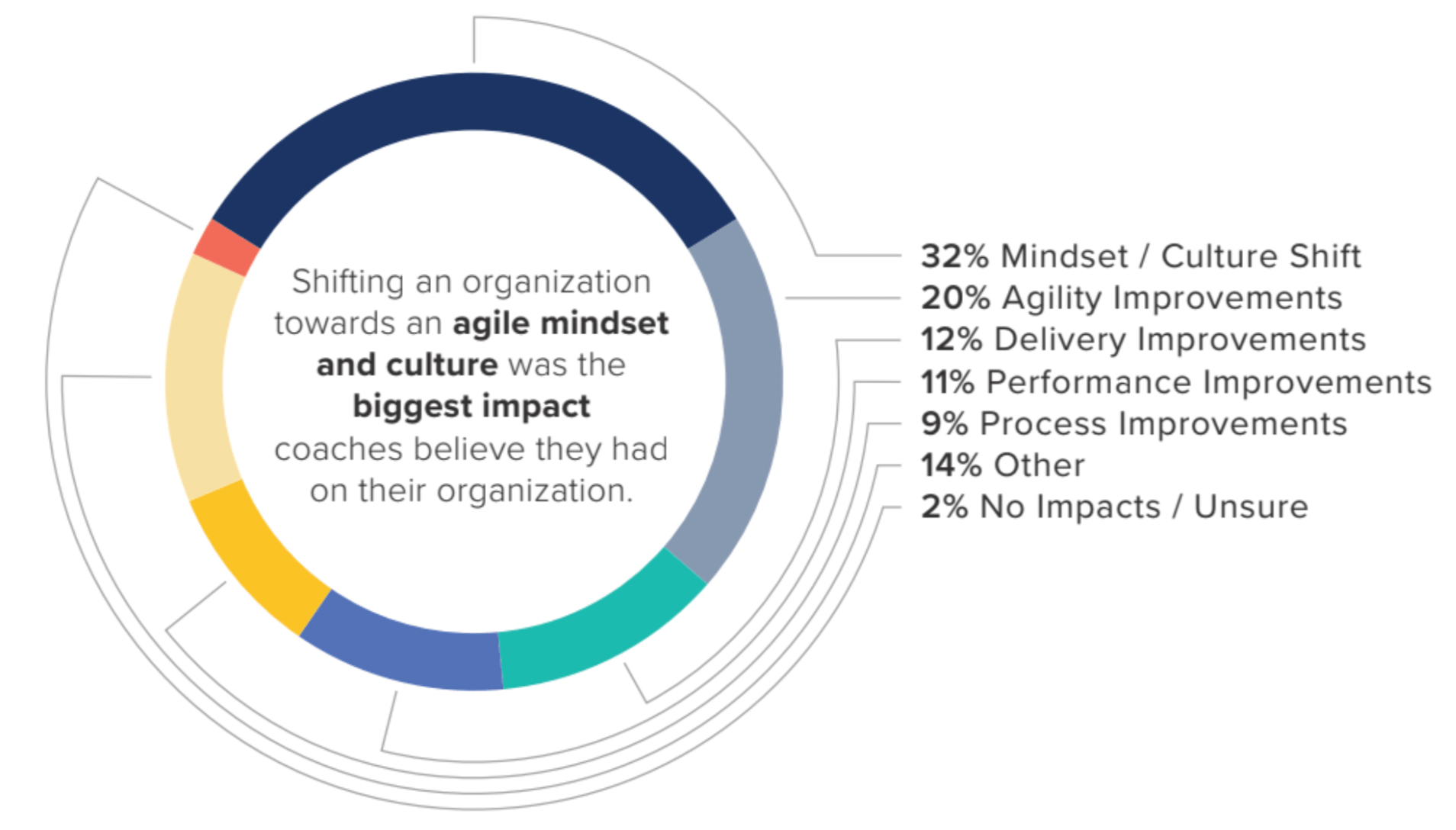
Thus, there is a reason why retrospectives are called the core ceremony in Scrum: They can help you solve the core challenges of Agile Coaches. Given these examples and facts, I hope you can see why many argue that outcomes are more important than outputs (in general, not only regarding Scrum retrospective for remote teams).
So now you know why I am listing these 10 features as core features of (free) agile Retrospective tools have selected that enable online retrospectives. Next, I'll explain why I claim we're comparing the 7 best retro tools.
Why are these the 7 “best" retro tools for your teams retro?
I wrote that these are the best retrospective tools for your teams retro and for running a retrospective remotely. Why am I claiming this - that they are the best?
Well, to be rather objective here, we tried to use numbers. In our case, we looked at website traffic. In the last months, these have been the pages with the highest traffic:

As you can see, the highest traffic overall have Parabol (red line) and easyretro (former FunRetro; purple line), then comes with some distance Echometer (blue) and the other tools to do retrospectives online - which are all on a similar level. I have to add that Neatro is not added here, simply because the Comparison tool we used for this (Ubersuggest) only allows you to compare 6 tools at the same time. I excluded it because Neatro has the least traffic from all the tools.
What you also cannot see: Of course, we compared many other retrospective tools to do retrospectives online (see below, the honorable mentions). Those simply had way less traffic compared to the 7 best tools we are talking about in this post - but they can still be a perfect fit for any Scrum retrospective for remote teams.
We also checked the traffic via Similarweb by the way, to have two different sources for the traffic data. It showed a similar pattern for the traffic of the Scrum retrospective tools. You can use Similarweb for free. So if you want to double check the traffic of the online retro tools on your own, feel free to do so.
Finally, it should be pointed out that higher traffic does not clearly prove that it is one of the “best” retro tools. However, for the purpose of this article, it served as a handy indicator as it was rather neutral.
Retrospective tools online: Some honorable mentions
To give you some names of which other retro tools we also checked in our traffic comparison (that might also be suitable for your teams retro), I added this section of honorable mentions. To find even more remote retrospective tools, feel free to jump into our retro board comparison post.
Online Retro Tool Alternative: Outro
“A new take on retrospectives for progressive teams.”
Outro website: https://outro.co/
What I like about it: Outro is a little side project by Taylor and Danny from NYC, who have a lot of experience with retrospectives. You can read their story and more about their tool on their website (More on: Project Retrospective Tool).
Online Retrospective App Alternative: GoRetro
“GoRetro is a user-friendly, fun and customizable agile retrospective tool that leverages sprint data and team sentiment to drive continuous improvement.”
GoRetro website: https://www.goretro.ai/
I haven’t tried this free online sprint retrospective tool, but it sounds and looks like a decent simple retrospective tool to do retrospectives online. Feel free to investigate on your own.
Online Retro Tool Alternative: Retrocat
“Easy peasy retros for you and your team.”
Retrocat website: https://retrocat.app/
Retrocat has all the basic functionalities of a free retrospective tool online. I didn’t dive deep enough to know how they perform on the core features I am mentioning above - but worth a look for sure. I have to admit: What I don’t get in case of this online sprint retrospective tool is the connection to cats…
Online Retro Tool Alternative: Miro
“Where teams get work done.”
Miro website: https://miro.com/
Okay, you have probably heard of Miro. It is probably the most popular digital whiteboard tool out there. Why am I mentioning it here? Because I know that many Agile Coaches and Scrum Masters use the Miro retrospective tool for their free online retrospectives, using an online whiteboard for their remote retrospective.
Advantages: Many are used to the handling of a whiteboard tool. And it is very flexible.
Disadvantage: You simply cannot call it a online agile retrospective tool. It does not have many of the necessary features of a fun retro online tool, including anonymity, action item support, ROTI score and health checks.
As above, if you are looking for an online whiteboard for a retrospective, I would rather Echometer or Metro Retro choose. The choice is yours as to which one you choose! Both are creative retrospective boards (More on: Creative Retrospective Board).
Online Retro Tool Alternative: Scatterspoke
“Run Better Retros. Build Happier Teams.”
Scatterspoke website: https://www.scatterspoke.com/
Scatterspoke calls themselves a data-driven tool. Which (as you might have noticed) I really like because I believe it can be of great help when it comes to getting the necessary outcomes out of retrospectives. An online agile central retrospective tool definitely worth keeping in mind.
Online Retrospective App Alternative: retros.work
“Get better team performance with online retrospectives.”
Retros.work website (pretty obvious): https://retros.work/
It looks like "retros.work" is a free online collaboration retrospective tool from a one-man show in the Netherlands – not bad! For this reason alone, this tool for online retros is worth a look (More on: Retrospective Collaboration Tool). But now, after all these retro tools, let's draw a conclusion.
Conclusion – Retro tool
The market for free retro tools is confusing. It makes it difficult for you to choose a tool. As my selection has shown you, many tools have their own approach to improving teamwork. At the same time, however, many tools also offer the same functions, so that it is often not clear at first glance which tool is suitable for which requirements.
This comparison post hopefully gave you a direction which retro online free tool to choose. Of course, as we are the developers of one of these tools, we are biased in which tool we recommend. But I tried to explain our decision framework for this recommendation as logically as possible. Feel free to give us feedback on our rationale.
If you are looking for some fun retrospective questions, feel free to have a look at these 32 kickass retrospective ideas View (More about: Software Retrospective Ideas).
By the way: One of the most effective ways to sustainably develop the agile mindset of teams is to carry out an agile health check. Our free 'team health check kit is there to help you implement it and ask the right questions. Just takes a minute to go through it 🙂
Have fun doing your next online retro - hopefully with the right tool!
Most Agile Coaches and Scrum Masters run in circles...
...fixing superficial symptoms. Time to use psychology to foster sustainable mindset change.

